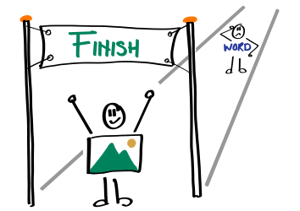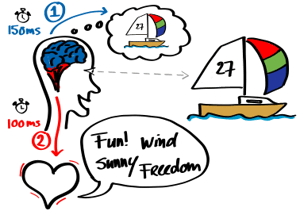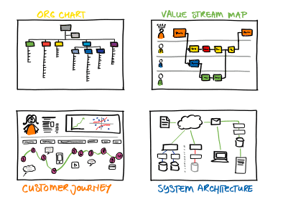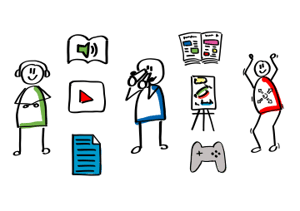A Picture Is Worth A Thousand Words: Accelerate Your Transformation With Visualization
In both our personal and professional lives, complexity is increasing exponentially. On average, we process about a hundred thousand words a day, which is about the equivalent of reading four Harry Potter  books a week. The amount of information we’re already processing impacts our ability to take in more. So, an organizational transformation, disruptive by nature, adds an onslaught of new information.
books a week. The amount of information we’re already processing impacts our ability to take in more. So, an organizational transformation, disruptive by nature, adds an onslaught of new information.
In addition to processing routine daily tasks, professionals must also learn, comprehend, and apply new skills and structures while synthesizing and adopting different mindsets, attitudes, and behaviors. Under these conditions, it’s critical for managers, teams, coaches, consultants and other stakeholders to present valuable information in an immediately accessible way.  Visualization is one tool you can use to accelerate impact and amplify effectiveness during your Agile transformation.
Visualization is one tool you can use to accelerate impact and amplify effectiveness during your Agile transformation.
This article is published in  . Agile NXT is a new magazine full of inspiration for professionals on the emerging Agile journey. It challenges you to think differently and improve yourself, your team, and company a little more each day.
. Agile NXT is a new magazine full of inspiration for professionals on the emerging Agile journey. It challenges you to think differently and improve yourself, your team, and company a little more each day. 
The Power of Visualization
Images have always been at the center of our stories, from prehistoric cave paintings to New York City’s subway maps. The most influential stories in history are those we can imagine and visualize. So, it stands to reason that if you want to shift a paradigm, you have to change the way people see it. Old images make new stories harder to imagine because they’re ingrained into our memory. Replacing old images with new visualizations helps people grasp information 
and imagine things differently. So, for instance, a sketched networked diagram can create fresh associations and replace an outdated organigram in our minds. Suddenly, we can “see” how this new way of working might work!
The Brain is a Terrible Word
Processor
Our brain is wired for visuals; seeing comes before words. At birth, we’re able to see and visually recognize long before we develop verbal skills. Moreover, when it comes to acquiring knowledge and learning new skills, even as adults, neuroscientists have confirmed that
visualization plays a dominant role.  We use different parts of our brain to interpret words than we do to process an image. An image can trigger us to stop, think, laugh, talk, and connect emotionally. The reason pictures are so much more powerful than words has to do with the way our brain sends and receives information. Half of the neurons in our brains are connected to sight.
We use different parts of our brain to interpret words than we do to process an image. An image can trigger us to stop, think, laugh, talk, and connect emotionally. The reason pictures are so much more powerful than words has to do with the way our brain sends and receives information. Half of the neurons in our brains are connected to sight.
With eyes open, two-thirds of the electrical activity that’s going on in the whole brain is associated with what we’re seeing. It takes the brain less than 150 milliseconds to recognize an image and less than 100 milliseconds to assign meaning to it. We are naturally-born pattern recognizers. Words are processed individually as images almost as quickly in our short-term memory. However, images interface directly with our long-term memory, creating lasting imprints. Images have priority.  When an image and text are in direct conflict, the image usually wins. Since we aren’t born with the cognitive ability to process words, it makes sense that words can’t beat images. So a picture truly can tell a thousand words. There are five ways we can use this understanding of visualization to speed up our Agile transformations and make them more effective.
When an image and text are in direct conflict, the image usually wins. Since we aren’t born with the cognitive ability to process words, it makes sense that words can’t beat images. So a picture truly can tell a thousand words. There are five ways we can use this understanding of visualization to speed up our Agile transformations and make them more effective.
1. Sketching Skills: Find Hidden and Essential Drawing Talent There’s probably at least one member with some affinity for drawing in every group or team. You can discover who they are by introducing visual activities. For example, start your organizational Agile awareness workshop with a drawing exercise. Ask group members to sketch out the character, skill set, or hobbies of other members. Provide an introduction to graphic facilitation
There’s probably at least one member with some affinity for drawing in every group or team. You can discover who they are by introducing visual activities. For example, start your organizational Agile awareness workshop with a drawing exercise. Ask group members to sketch out the character, skill set, or hobbies of other members. Provide an introduction to graphic facilitation
or sketchnoting. Simple visualization tools like these can energize, connect, and empower people to create a new (transformation) story.
2. Pictures: Travel Journal
Just as you would for a personal holiday or trip, you can document the journey of the transformation with pictures. Capture the essence of conversations and decisions by including visualization in every interaction. Make sure plenty of whiteboards or flip-overs are available, with lots of colored markers. Incorporate images into chats; they’re more effective when the dialogue works towards a shared and immediate visualization. Also, at moments of agreements or disagreement, remember to take a snapshot of the situation; it will help you remember and recall the conversation. Use these pictures to create a daily or weekly journal and add relevant keywords as well.

3. Talking Pictures: Shared Complexity
During a transformation, it’s often assumed that everyone shares the same concept of the situation. However, each person may have a different understanding of the current organizational structure, internal processes, customer journey, or system landscape.  Until we visualize and share our different interpretations through images, we may think we’re all in agreement. So, start every transformation by collectively visualizing these four aspects to help the “transformers” see and acknowledge the complexity of the situation. Not only will these insights add value during the transformation, but they can also help you identify short-term improvements that yield direct results sooner.
Until we visualize and share our different interpretations through images, we may think we’re all in agreement. So, start every transformation by collectively visualizing these four aspects to help the “transformers” see and acknowledge the complexity of the situation. Not only will these insights add value during the transformation, but they can also help you identify short-term improvements that yield direct results sooner.
4. Style: Congruent Visualizations
When creating a visualization, try to make the styles congruent with the content. You can distinguish between the present situation and the ideal future one by creating a congruent visualization for each. Give each paradigm its own unique look. Choices in color, shape, and line influence our emotions and experience. So, for example, use PowerPoint building blocks to
visualize the current paradigm and sketchnote the new situation with a tablet or by digitizing physical drawings. This will make it clear that we're dealing with a “new story.” The visualizations become even more powerful when their style is also congruent with the culture and mindset behind the story that’s being told. 

5. Communication Media: Initiation of Co-Creation
People interpret and process information and experiences differently when it comes to learning and changing. Some people are visually oriented, some people “think with their ears,” while others are more kinetically inclined.  You can combine different media to involve everyone in the transformation story. For example, a physical booklet, PDF, video, poster, or game can help make the same story more tangible in different ways, creating an emotional connection with everyone. It’s all about involving the largest possible part of the organization in the co-creation process of the transformation.
You can combine different media to involve everyone in the transformation story. For example, a physical booklet, PDF, video, poster, or game can help make the same story more tangible in different ways, creating an emotional connection with everyone. It’s all about involving the largest possible part of the organization in the co-creation process of the transformation.
Images Not Words!
There’s untapped visual talent hidden within every organization. You can put its power to work
to increase the speed and effectiveness of your Agile transformation. By implementing the five suggestions in this article, you can help people break old patterns and shift paradigms.
Stop Talking and Start Drawing
Images have more power than words! In recent years we’ve seen a surge of uses for drawing in
business: graphic facilitators help develop new strategies; video animations explain new ways of working; sketchnoters and trainers document conferences and events; people use Nueland® pens and flip-over sheets to create visually rich Powerpoint® slides. Xebia Academy offers visualization training designed explicitly for change experts to accelerate more impactful transformations.
 Want to know more about visualization of your Agile process? Download
Want to know more about visualization of your Agile process? Download  and start your personal change tomorrow.
and start your personal change tomorrow.





